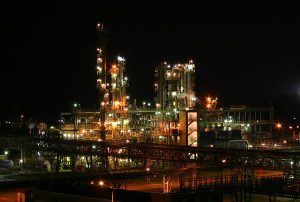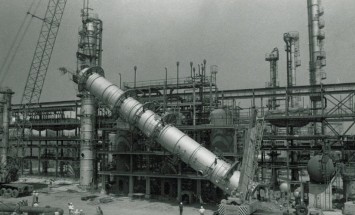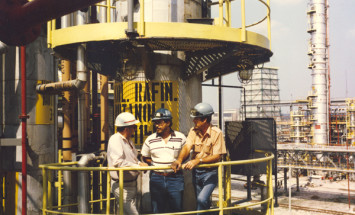Beginnings of OXO production plant
In 2015 the most modern system for manufacturing the first Polish non-phthalate plasticiser – Oxoviflex® – produced based on OXO alcohol (2-Ethylhexanol) was started. Grupa Azoty ZAK S.A. is the only in Poland and the fifth largest company in Europe producing OXO alcohols, and the largest Polish and fifth largest European company producing plasticizers.
The history of chemical industry in Kędzierzyn-Koźle dates back to 1940 when the German chemical group IG Farben began to build a chemical plant in the area to produce synthetic petrol from coal. Production was started at the end of 1943 but the production systems were damaged during bombing. At the end of World War II, when Russians occupied Kędzierzyn, the systems and apparatus were completely dismantled in the factory.
In 1948 the government made a decision to establish Zakłady Przemysłu Azotowego “Kędzierzyn” with its head office in Bierawa on 1 January 1949. Productionbegan in 1954 with starting a fertilizer line. A year later production of phthalate anhydrite, waxes, aminoplasts and fatty acids commenced. The plant was gradually extended.
The history of OXO dates back to February 1979 when a contract for building an OXO Alcohol Production Plant was signed with the German company Zimmer AG. The licence was purchased from Union Carbide Corporation (UCC) and Davy Mc Kee (currently Davy Process Technology) for the “OXO” technology awarded for high advantages with the prestigious Kirk-Patrick award. Initially, the project was intended for implementation in the period 1980 – 1982. Design works began and some equipment was ordered but the crisis of 1980-1981 and the martial law in Poland interrupted the activities. The determination of the employees, first and foremost of the General Director at that time, Konstanty Chmielewski, contributed to resuming of the project in the second half of 1982. The formal permit to start the activity was obtained from the government in June 1982. It was then when proper construction and implementation of the investment started. Besides constructing of the OXO alcohols production plant the investment also covered building of a Synthesis Gas and Hydrogen Production Plant (produced by low-pressure semi-combustion method) and a number of other activities in the Zakłady Azotowe “Kędzierzyn” (as it was then called). Opolskie Przedsiębiorstwo Budownictwa Przemysłowego No. 1 was the general contractor. 17 companies participated in the investment implementation. The engineering staff responsible for the start-up and maintenance were trained, according to the licence agreement, at the operating UCC OXO alcohols system in Texas City, USA. Specialists in chemical analysis were sent for training to the United Kingdom. On 30 December 1986 the acceptance protocol of the OXO Alcohols Production Plant was signed. It was then among the three largest global systems of that kind. Roughly about 10 thousand tons of construction elements and approximately 5 thousand tons of different machines and apparatus were used for construction.
Anniversaries encourage reflexions and evaluations of the previous achievements. OXO alcohols produced for 30 years greatly affect the financial results of Grupa Azoty ZAK S.A. and the company’s position on the map of the Polish and European chemical companies. However, these are people who make the foundations of the 30 years of OXO history, and their memories related to OXO alcohols systems and the experience creating the current value of the company will be presented in the following papers.




